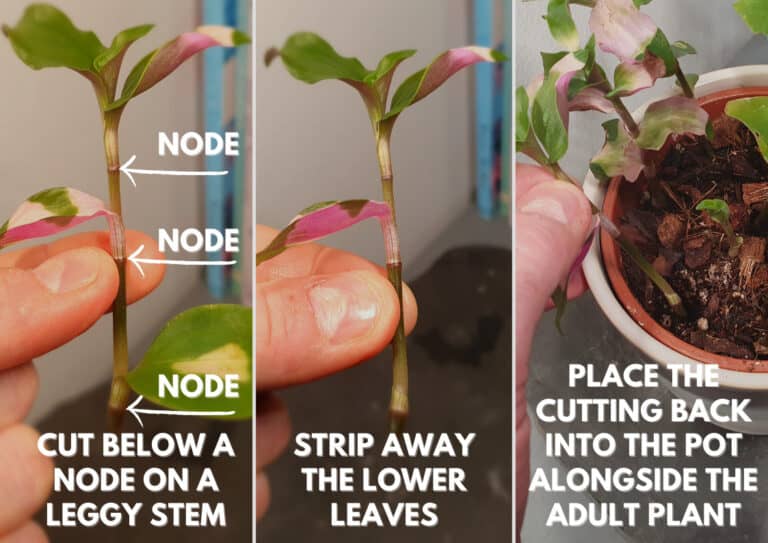How To Pinch Wandering Jew To Make It Bushy?
- Lakeisha Ethans
- January 16, 2023
If you buy something using the retail links in our articles, sometimes we earn a small affiliate commission. This does not impact the products we recommend.
Though they can make for beautiful houseplants, Wandering Jew (Tradescantia sp.) tend to get leggy. Their tendrils make for fantastic groundcover but few people are after that aesthetic when keeping them as indoor plants.
If you want a robust, thick plant that is bushy, dense with foliage and ‘full’ you might have to do a little cultivating to
First pinch out particularly leggy Wandering Jew stems back to the first or second node to encourage foliage that re-grows in a compact form. Secondly, propagate the cuttings obtained from the leggy stems by planting them straight back into the pot to create an overall bushier appearance.
Before doing any pruning however it is worth noting that excessive legginess can simply be a result of sub-optimal care so it’s a good idea to carry out a quick check using the points below to make sure you’re not fostering a plant that will continue to grow stretched and leggy until the end of days.

How do you prune a Wandering Jew to encourage compact growth?
To create a fuller looking Wandering Jew plant apply the following steps:
- Locate the leaf nodes on a particularly leggy stem – these are small, swollen rings where leaves and eventually roots are produced from.
- Break through a leggy stem just a little bit above a node so that the stem is reduced in height to 2″-3″. This mature stem will begin to re-generate new leaves.
- Use the leggy stem that has been removed to generate a cutting of a few inches in length.
- To prepare the cutting trim the stem close to beneath a node before stripping all but the top couple sets of leaves.
- Place the cutting back into a space in the pot.

When choosing stems to pinch out, prioritize thin, weak, and fragile ones. These are more likely to develop leggy growth that detracts from a preferred bushy appearance, and they’ll only get even leggier over time.
Of course you won’t get many healthy cuttings from these sections of the plant however it will allow the plant to place its energy into healthy foliage.
If you’re looking to use propagation as a tactic to create a bushier plant it’s a good idea to focus on pinching stems that aren’t too new (i.e. those that measure less than six inches above the level of the soil).
Immature stems will be less likely to yield cuttings and pruning them many end up stunting the growth of the plant overall and work against the aim of creating a bushy appearance.
Wandering Jew plants are quite soft, so you might be tempted to pinch out the stems with your nails. This shouldn’t bring about any negative effects to the plant but you will be left with a ‘cut’ edge that is crushed and invites rot or disease to take hold more easily.
Why is my Wandering Jew leggy? (and how do you stop this from happening?)
The most common care-related cause of a leggy Wandering Jew is a lack of sufficient light.
As a low-light plant, Wandering Jews devote a lot of their energy to creeping and seeking out exposure to sunlight in order to gain energy and generate sugar for photosynthesis and nourishment. When you fail to provide that lighting easily, your plant has to stretch out in an attempt to locate the light it needs.
This is likely to become more noticeable during cold seasons when natural sources of light become more scarce. You’ll see the plant lean toward any light and may see a loss of variegation or lower leaves. You may also notice stunted growth and foliage may begin to yellow.
Simply move your Wandering Jew plant to a brighter spot to solve this issue. Indirect sunlight is best to avoid scorching its leaves while also ensuring it doesn’t need to travel to gain access to light.
Another common issue is incorrect pot sizes. Since it grows so aggressively, Wandering Jew plants can very quickly outgrow their initial containers. Once you see roots pushing out of the bottom alongside leggy tendrils, it’s time to repot the plant if you don’t want it to become a creeping type of flora.
As a general rule, Wandering Jew plants should be repotted every 1 ½ – 3 years, depending on their speed of growth. New pots should always be at least two inches wider than the former pot. It’s also best to pot in early spring so you can get ahead of the upcoming potential growth spurt.
Finally, your Wandering Jew may become leggy if it is given too much nitrogen-rich fertilizer. This is because the nitrogen content encourages quick spikes in stem growth, but doesn’t help the plant to push out green leaves to cover those stems.
The fix for this is easy – just reduce the amount of fertilizer you give to the plant. You should only give a Wandering Jew plant a water-soluble, general-purpose fertilizer for houseplants once every one to one and a half months. To play it safe you could dilute the fertilizer so it is half as strong as the label recommends.
Round up
Wandering Jew plants grow quickly and have evolved to become naturally leggy as they creep along the ground to seek new resources.
To maintain a bushy looking Wandering Jew instead of a spindly one, you must regularly pinch and prune thinner and longer stems to prevent overly elongating tendrils. Replanting cuttings taken from long stems into the same pot will fill out any gaps in the foliage and create a more aesthetically pleasing appearance.
Of course, there are also other issues that could continue to promote legginess. A lack of sufficient lighting, poor pot sizes, and excessive fertilizer use are all common culprits when it comes to overly long Wandering Jew plants. Sort these factors out and your Tradescantia will begin to grow more lush all by itself.

Lakeisha Ethans
Houseplant Writer
Mother to two humans and hundreds of plant babies. Lakeisha uses her 15 years of experience as a content writer to specialise in simplifying what you need to know to grow and care for all indoor plants.
Similar Posts
Should I Cut Off Damaged Monstera Leaves?
Damaged Monstera leaves can ring alarm bells for plant owners. Should you cut them off, or will that do more harm than good to the plant?
Feng Shui Plant Ideas For A Wealthy Office {Lucky Plants Only!}
Luck comes in many forms, and there are indoor plants that deal with all different elements, from love, to money, and health.



